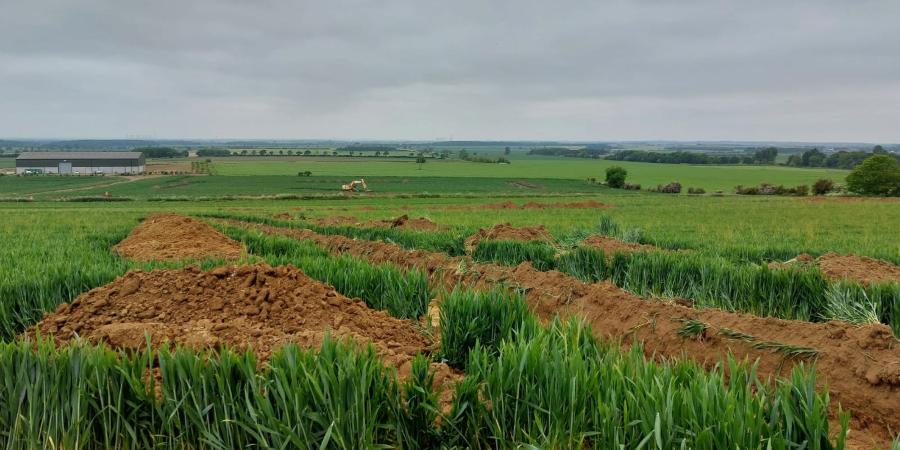53.405334061934, -0.64187141996051
Project summary
- Client: Tillbridge Solar Limited
- Project duration: April 2023 - ongoing
- Location: Lincolnshire
- Sector: Energy
Notable numbers
- The site has 14 different landowners and covers 126 fields
- We recovered 312kg of archaeological finds
Wessex Archaeology was commissioned by Tillbridge Solar Limited to undertake evaluation work across a huge area, approximately 1,400 hectares, in Lincolnshire, to inform planning consent for a proposed solar farm. Classified as a Nationally Significant Infrastructure Project (NSIP), Tillbridge Solar Project aims to generate more than 50 megawatts of renewable energy, help to achieve the UK’s net zero targets and make a vital contribution to the UK’s energy security.
Left: Our team excavated over 2,800 trenches covering 28 hectares, revealing archaeology from the Late Neolithic to Romano-British
Right: Uncovering one of the hotspots of Romano-British activity
Supporting the renewable energy sector with archaeological work
In April 2023, we sent a large team of field archaeologists, divided into four groups, to excavate different sections of the site. As set out by the Local Authority Archaeologist, we evaluated a 2% sample, which covered 28 hectares, digging approximately 2,800 trenches, all measuring 100 square metres.
Following this evaluation trenching, our researchers produced a series of individual reports, alongside a combined report, detailing our findings and the nature and preservation of archaeology within the area. As agreed with the client at the outset, these reports were delivered within a defined timeframe so they could be submitted as part of the Development Consent Order.
Our archaeologists are due to return to the site to undertake evaluation trenching along the route of the proposed cable trench, which would connect Tillbridge Solar Project to National Grid’s Cottam substation in Nottinghamshire.
Challenges and how we overcame them
The biggest challenge was organising the logistics for the large number of experts involved in the project. As well as stakeholders and machine operators, we had up to 50 archaeologists on site at any one time and with that came a huge amount of planning. Along with the Project Manager, our dedicated Logistics Officers liaised with landowners to organise access, acquired all the necessary plant machinery and, as this project required relocating a team of field archaeologists, managed accommodation arrangements.
Mindful of the concerns from some members of the local community about the scheme we were acutely sensitive to the needs of residents. The team did everything possible to avoid causing disruption, whether that be giving priority to oncoming vehicles or refraining from using machinery outside of standard working hours.
Above: Our archaeologists uncovered 15–20 hotspots of Romano-British activity
The archaeological findings and multi-disciplinary research
Our investigations led to the discovery of remains from a range of periods. In a pit excavated at the base of the Lincoln Cliff, we found a large flint assemblage and 19 sherds of Beaker pottery, both of which are of late Neolithic to Early Bronze Age in date. The pit also contained charred plant remains and charcoal, indicating likely settlement activity nearby. There is limited evidence for late Neolithic and Early Bronze Age activity across Lincolnshire, so our findings are of regional significance.
Our archaeologists also uncovered 15-20 hotspots of Romano-British activity, averaging at one settlement per kilometre-and-a-half, providing insights into the density of Romano-British occupation of the area.
In the southwest corner of the site, we found evidence of RAF Sturgate, built during World War II. While a small section of the airfield remains in operation, we discovered some of the old runway structure and drainage parts.
Some of these features were preserved in situ and others were carefully removed for analysis by our in-house specialists.
Our investigations for Tillbridge Solar Project can be synthesised with two local sites we studied previously – at Gate Burton and Heckington Fen – to produce a broader understanding of the region’s archaeology.
Tillbridge Solar Project is a fantastic example of how our experts in a range of specialisms can work together on a large-scale project to support a client’s aims. This project was a multi-disciplinary effort, including field, artefact, environmental and period-specific experts. Our specialists combed through the vast expanse of data and delivered detailed results within the agreed timeframe.
“Archaeological evaluation work can be one of the most challenging aspects of the development process,” said Luke Murray, Director, Tillbridge Solar Limited. “Our work with Wessex Archaeology enabled the project team and the local authority archaeologist to develop an understanding of what was present at the Tillbridge site. The quality and outcomes of the work that Wessex carried out have been reflected in the progress of our Development Consent Order application.”
